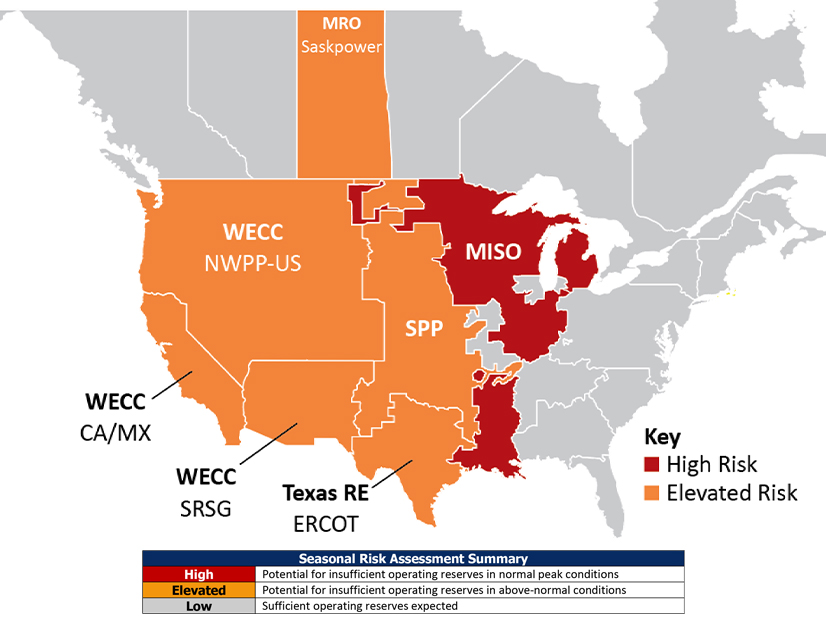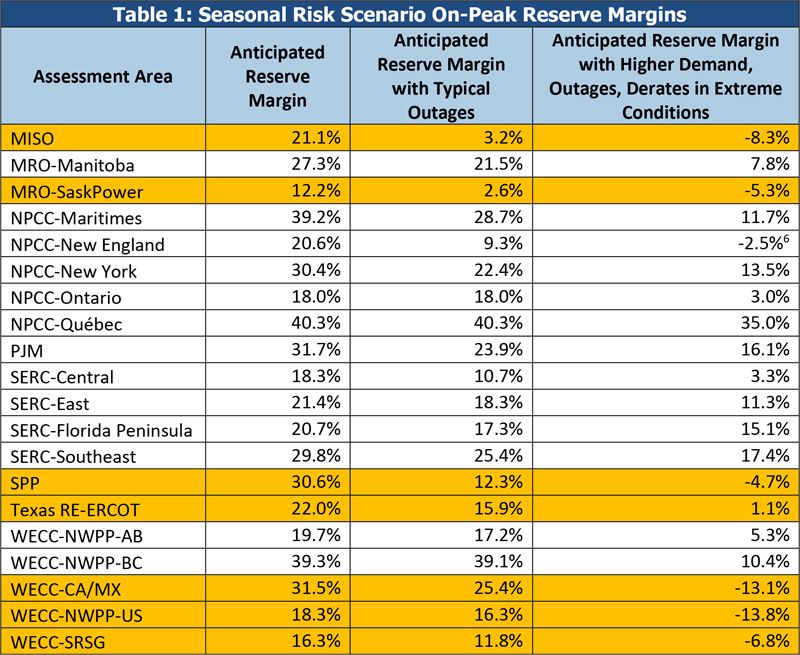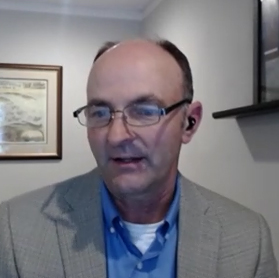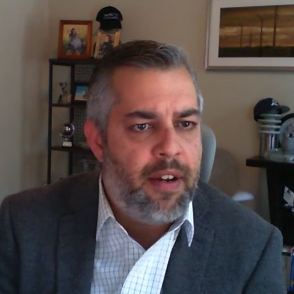
Drought, wildfires, plant retirements and transmission outages have elevated the risk of supply shortfalls in the West, Texas, MISO and SPP, NERC said in its Summer Reliability Assessment on Wednesday.
“It’s a pretty sobering report,” John Moura, NERC’s director of reliability assessment and performance analysis, said in a media briefing. “It’s clear the risks are spreading. … Year after year, extreme weather is leading to reliability impacts.”
MISO’s North and Central areas face a “high risk of energy emergencies during peak summer conditions” because of a capacity shortfall and the outage of a key transmission line, NERC said in the assessment, which covers June to September. Drought is the cause of concern in Texas, and drought and wildfire risks will present challenges in the West, the report said.
Risk of Load Sheds in MISO/MRO
MISO has been unable to reverse capacity shortfall projections NERC has reported since 2018, with load-serving entities in four of its capacity zones currently lacking sufficient owned or contracted capacity to cover their requirements. (See OMS Drafting Letter over MISO Resource Adequacy Concerns.)
 On-peak reserve margins for summer 2022 | NERC 2022 Summer Reliability Assessment
On-peak reserve margins for summer 2022 | NERC 2022 Summer Reliability AssessmentThe RTO faces both a 1.7% increase in projected peak demand — largely a rebound from the pandemic — and a 2.3% (3,200 MW) reduction in generation capacity compared with summer 2021.
“System operators in MISO are more likely to need operating mitigations, such as load-modifying resources or non-firm imports, to meet reserve requirements under normal peak summer conditions,” NERC said. “More extreme temperatures, higher generation outages or low wind conditions expose the MISO North and Central areas to higher risk of temporary operator-initiated load shedding to maintain system reliability.”
MISO also will enter summer lacking a 500-kV transmission line that was damaged by a tornado in December. That will affect 1,000 MW of firm transfers between MISO Midwest and South, including parts of Arkansas, Louisiana and Mississippi. Restoration of a 4-mile section of the line is expected at the end of June.
Canada’s Saskatchewan, which is part of the Midwest Reliability Organization, has seen a 7.5% increase in projected peak demand since 2021. Although SaskPower is projected to remain above its planning reserve margin, with sufficient operating reserves for normal peak conditions, “external assistance is expected to be needed in extreme conditions that cause above-normal generator outages or demand,” NERC said.
Dry in the West, Texas, SPP
Drought conditions in Texas and much of the West threaten to reduce hydropower output and pose “unique challenges to area electricity supplies and potential impacts on demand,” NERC said.
Below-normal snowpack threatens the availability of hydroelectricity for transfers throughout the Western Interconnection, a particular risk for WECC’s California-Mexico (CA/MX) and Southwest Reserve Sharing Group (SRSG), which depend on imports to meet demand on hot summer evenings and other times when wind and solar output are reduced. “In the event of wide-area extreme heat event, all U.S. assessment areas in the Western Interconnection are at risk of energy emergencies due to the limited supply of electricity available for transfer,” the assessment said.
Much of Texas also faces extreme drought, which NERC said “can produce weather conditions that are favorable to prolonged, wide-area heat events and extreme peak electricity demand.”

Recent additions of solar and wind have raised ERCOT’s anticipated reserve margins above reference margin levels, meaning the grid operator should have sufficient capacity for normal peak demand. But extreme heat will increase peak demand and could cause a spike in forced outages or reduced output from generating resources. “A combination of extreme peak demand, low wind and high outage rates from thermal generators could require system operators to use emergency procedures, up to and including temporary manual load shedding,” NERC warned.
 Mark Olson, NERC | NERC
Mark Olson, NERC | NERCMark Olson, manager of reliability assessments, said another risk is the retirement of thermal plants and influx of renewables.
“There are fewer and fewer thermal plants in a number of areas as generation retires. So the ones that are remaining are being driven hard. They have to cycle to be able to balance variable energy,” he said.
“That takes a toll on the plants. So we can expect to see higher forced outage rates in the future [and] more generation mechanical issues.”
Continued drought in the Missouri River Basin also could result in reduced output from thermal generators in SPP that use the river for once-through cooling. Output from hydro generators on the river may also be reduced.
Solar PV Tripping Remains an Issue
Unexpected tripping of solar PV resources during grid disturbances remains a problem despite attempts to address it since 2016, with widespread losses last May and June in Texas and four events in California between last June and August.
“During these events, widespread loss of solar PV resources was also coupled with the loss of synchronous generation, unintended interactions with remedial action schemes and some tripping of distributed energy resources,” NERC said.
Since the 2016 Blue Cut Fire in California, which caused nearly 1,200 MW of solar PV to trip offline, NERC has been warning that the lack of inverter-based resources’ (IBRs) ride-through capability risks turning minor system disturbances into major ones.
NERC said a series of trips last year “reinforces that improvements to NERC reliability standards are needed to address systemic issues with IBRs,” an issue highlighted in a joint NERC-WECC report last month. (See NERC, WECC Repeat Solar Performance Warnings.)
The report said that the one inverter manufacturer involved in the Blue Cut Fire “quickly and proactively responded by ensuring that all [bulk power system]-connected solar PV facilities changed their frequency protection settings to avoid future issues. However, these disturbances in 2021 involve different inverter manufacturers, illustrating that the issue is still not widely understood or addressed across all manufacturers and plant owner/operators.”
Although NERC standards require documentation that demonstrates compliance with ride-through requirements in PRC-024-3, “they do not specify a certain degree of performance that must be met,” the organization said, calling for the standard to be retired and “replaced with a comprehensive ride-through standard that focuses specifically on the generator protections and controls.”
NERC “strongly recommends that a performance validation standard be developed that ensures that reliability coordinators, transmission operators or [balancing authorities] are assessing the performance of interconnected facilities during grid disturbances, identifying any abnormalities and executing corrective actions with affected facility owners to eliminate these issues.”
On Wednesday, NERC’s Standards Committee approved the Inverter-Based Resource Performance Subcommittee’s request to approve a standard authorization request to address the issue. (See “Other Standards Actions” in NERC Cold Weather Standards Set for Shortened Comment Period.)
 John Moura, NERC | NERC
John Moura, NERC | NERC“These types of risks have the potential to have a widespread impact across the entire interconnection, and that’s really the entire Western Interconnection, or the entire Eastern Interconnection, or the entire Texas Interconnection if you’re in ERCOT,” Moura said. “It’s a matter of keeping the balance of supply and demand. And if the supply and demand balance is shifted — even 1,000 MW very quickly — that really creates real trouble for the operators. They’re not used to dealing with this huge imbalance.
“The inverter tripping challenge is really one of the most risky issues I think we have to deal with as an industry in order to ensure we can reliably integrate interconnect the nearly 500 GW of solar we see coming online in the next 10 years,” he added.
NERC also has issued recommendations that electromagnetic transient (EMT) modeling and studies be incorporated into its reliability standards. “Existing positive sequence simulation platforms have limitations in their ability to identify possible performance issues, many of which can be identified using EMT modeling and studies,” NERC said. “As the penetration of IBRs continues to grow across North America, the need for EMT modeling and studies will only grow exponentially. Furthermore, NERC reliability standards need enhancements to ensure that model accuracy and model quality checks are explicitly defined.”
Moura said NERC wants FERC to add a requirement for EMT modeling in its pro forma interconnection agreement to ensure reliable connection of asynchronous inverter-based resources: solar, batteries or wind.
“In the past, when you interconnected a synchronous generator, you simply do a power flow analysis, a voltage stability analysis and a feasibility study,” he said.
When IBR resources were a smaller contributor, “maybe we didn’t need to do those [EMT] studies. But as … we’re seeing more and more, these types of studies are absolutely necessary. We cannot integrate resources reliably without doing those studies.”
Other Reliability Issues
NERC also identified several other concerns:
- Supply chain problems and staffing shortages are hampering efforts to complete new generation and transmission projects needed for reliability. WECC-CA/MX and WECC-SRSG “have sizeable amounts of generation capacity in development and included in their resource projections for summer,” while ERCOT is rushing to complete transmission projects to address transmission constraints and maintain system stability, NERC said. It warned of transmission congestion during peak conditions and reduced ability to serve load in localized areas. It said generator and transmission owners must inform their BAs, TOPs and RCs of any delays so they can develop responses.
- Supply chain problems are also making it difficult for some coal-fired generators to obtain fuel and other supplies, with coal stockpiles “relatively low” compared to historical levels. Coal plants say their fuel supplies have been pinched by mine closures, rail shipping limitations and increased coal exports. “No specific BPS reliability impacts are currently foreseen,” NERC said.
- The grid and other critical infrastructure sectors face cybersecurity threats from Russia and other potential actors, particularly because of Russia’s invasion of Ukraine. The Electricity Information Sharing and Analysis Center is sharing information with its members on potential threats.
- An active late-summer wildfire season in the Western U.S. and Canada also poses threats. Above-normal wildfire risk is expected beginning in June across much of Canada, in the U.S. South Central states and in Northern California. In New Mexico, the Hermits Peak/Calf Canyon Fire has grown to almost 300,000 acres, making it the largest in state history. “If drought conditions persist, the fire outlook for late summer would likely extend across the Western half of North America,” NERC said, noting the potential for damage to transmission lines or pre-emptive shutdowns to avoid sparking blazes. In addition, smoke from wildfires can reduce output from solar PV.



